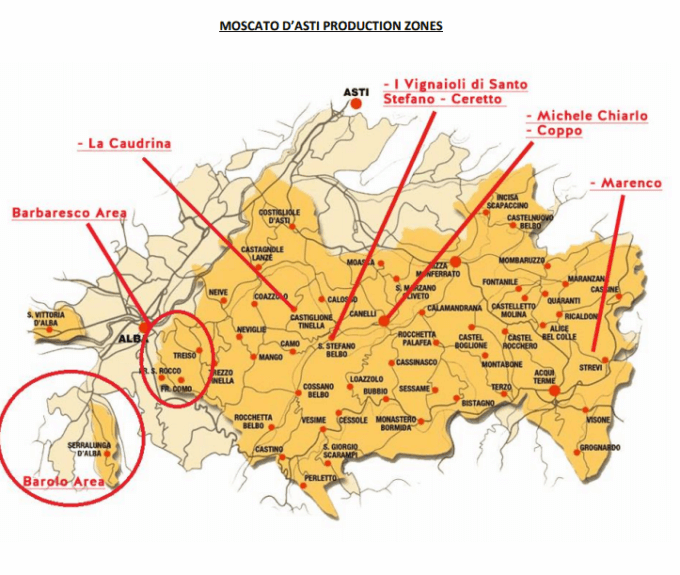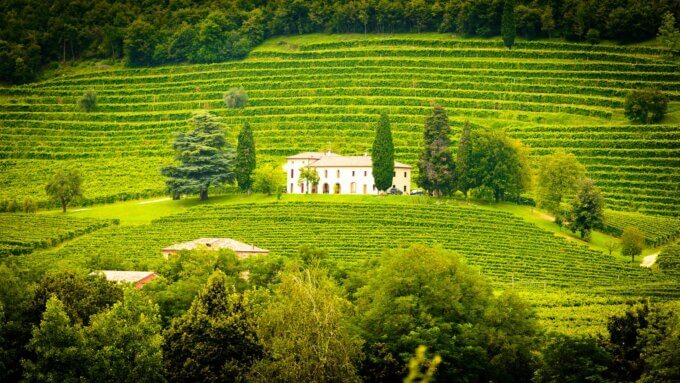Be social! Share the fun!
Sweet Moscato

Are you curious about sweet Moscato wine?
Sweet Moscato is a wine from the Moscato grape.
Famous in ancient Rome and noted by the historian Pliny, sweet Moscato grows all over the world.
But the most famous wine from the sweet Moscato grape is Moscato d’Asti.
Like many wines from Italy, the name “Moscato d’Asti” refers to the grape variety (Moscato) and the town where it comes from, Asti.
But the most famous wine from the sweet Moscato grape is Moscato d’Asti Click to Tweet
Sweet Moscato in Piedmont

Moscato d'Asti DOCG in Piedmont
Asti lies in the Piedmont region of northwest Italy, bordering Switzerland and France. The name means “foot of the mountain” in the Italian language. Rolling hills characterize the landscape.
The best sweet Moscato wine comes from the higher elevation hillsides. Higher altitudes lead to cooler temperatures. Sweet Moscato wine needs high acidity to act as a counterbalance to its high sugar content.
Sugar Content in Sweet Moscato
The residual sugar (sugar left over from fermentation) in sweet Moscato ranges from 70 grams per liter (very low for sweet Moscato) to nearly 130 grams per liter, depending on the character of the vintage.
Warm weather leads to greater ripeness at harvest, while cool temperatures restrict this ripeness and the sugar level.
How Sweet Moscato is Made

Moscato d'Asti DOCG Sweet Moscato

By DOCG regulations, the producers receive notification when they may pick the grapes. This coincides with their peak of ripeness.
Workers take the freshly picked grapes to the individual wineries. Here, workers press them softly, inoculate them with yeast, and ferment them.
To keep the sweetness in the wine, workers stop the fermentation when the alcohol reaches 5%, though the range is officially between 4.5 and 6%.
The atmospheric pressure must be under 2.5 bar.
Instead of bottling the wine, workers freeze the sweet Moscato until they receive an order. This way, the sweet Moscato stays fresh until needed.
Moscato d’Asti is different from Asti Spumante. How so? Click Here
Asti DOCG Regulations
DOCG stands for Denominazione di Origine Controllata e Garantita.
To receive the DOCG designation, Asti had to prove its unique terroir and long history of quality winemaking.
Like the less restrictive DOC designation (Denominazione di Origine Controllata), the producers in the Asti DOCG must abide by the region’s permitted grape varieties and a myriad of other laws pertaining to viticulture and vinification, and maturation techniques.
The mandates of the sweet Moscato d’Asti DOCG is such that the producers must submit the wine for an in-depth technical analysis and tasting from the Ministry of Agriculture.
Only then will they receive the official DOCG seal of approval.
The Aromas and Flavors of Sweet Moscato

Sweet Moscato: Floral Aromas
Sweet Moscato wine has exotic floral aromas of honeysuckle and jasmine, and ripened fruit like pear, peach, and apricot.
Many tasters can even detect herbal notes like sage.
Sweet Moscato and Health

Sweet Moscato: Healthy Choice In Moderation
Are you on the Keto Diet? Low Carbs? If your diet permits you a daily indulgence, put sweet Moscato on your treat list.
The “secret” is to pour an ounce of this delicious sweet wine into a glass and add zero-carb and zero-calorie seltzer water or tonic.
Decorate the rim of the glass with a slice of lime and you have your lower calorie, lower carbohydrate treat.

Sweet Moscato: When To Serve?
Welcome visitors to your home with sweet Moscato wine served in an elegant fluted glass, like Champagne.
Sweet Moscato is best paired with dessert. I love it with Italian cookies! Sweet Moscato also pairs great with berries. Add Italian vanilla ice cream for a special treat.
You can even serve sweet Moscato at lunch or dinner to pair with items served with the main meal. See my recipe for a vegetarian friendly Robiolo cheese entrée at the end of this article.
Moscato Where to Buy

Supermarkets & Wine Shops
You can find sweet Moscato wine everywhere, supermarkets and wine shops. Your favorite online shop should have a great selection.
Can Sweet Moscato Wine Go Bad?
Every wine, once opened, is perishable. Yet you can keep your sweet Moscato for a few extra days with the technique below.
Try to pour the leftover sweet Moscato wine into a small container, like a glass jam jar or bottle used for salad dressing. Turn the cap tightly and place in the refrigerator. This should last two days.
5 Sweet Moscato Wines to Try
MONCALVINA MOSCATO D’ASTI D.O.C.G. 2019 – COPPO
LA CAUDRINA MOSCATO D’ASTI D.O.C.G. 2019 – CAUDRINA
NIVOLE MOSCATO D’ASTI D.O.C.G. 2019 – MICHELE CHIARLO
MOSCATO D’ASTI D.O.C.G. 2019 – I VIGNAIOLI DI SANTO STEFANO – CERETTO
SCRAPONA MOSCATO D’ASTI D.O.C.G. 2019 – MARENCO VINI
Virtual Visit of Sweet Moscato Producers

The producers representing these wines recently gave a virtual conference to New York wine writers. Last year; they flew to New York and gave the presentation in person.
Thankfully, they could send their wines so that participants in the webinar could taste the 2019 vintage.
Though each sweet Moscato wine shared key characteristics like floral aromas, they differed slightly in terms of their fruit profile and intensity of savory herbs like sage. This reflects the different terroir and altitude of each producer’s vineyards.
Moscato remains one of the most delicious and affordable of all Italian wines. It’s the perfect choice for a picnic, or just an apéritif.
Moscato remains one of the most delicious and affordable of all Italian wines. Click to Tweet .
Sweet Moscato with Robiola Cheese and Grilled Vegetables

Robiola is an Italian soft-ripened cheese of the Stracchino family. It thrives in the Langhe region of Piedmont and made with varying proportions of cows, goat, and sheep milk.
You can also substitute a mixture of 1/2 cup mascarpone and 1/3 cup ricotta for Robiola if unavailable.
The Pesto Robiola Sauce
To prepare the sauce, place basil, garlic, pine nuts, 1/4 cup of olive oil and 1/2 teaspoon of salt in a food processor and run until smooth, scraping down the sides of the bowl as needed.
Then add the cheese and pulse just until combined. Make this mixture ahead and refrigerate. Bring to room temperature before serving.
Though your guests can just serve themselves the vegetables and pesto Robiola separately, I like to make a more formal presentation.
The Formal Presentation of Robiola Cheese, Grilled Vegetables, and Sweet Moscato
For presentation, I like to serve this dish in an oversized wine tumbler from Riedel. When you’re not using the glasses for this dish, you can use it for red wine.
To do this, I use the largest stemless glasses from Riedel
First, I chop the grilled vegetables and mix them.
Then I spoon a shallow layer of the vegetable mixture into each glass.
I add another shallow layer of the cheese mixture.
Then I repeat the process until the glass has alternating layers of the cheese mixture and the vegetable mixture.
I like to decorate this with a sprig of rosemary.
Serve with chilled sweet Moscato!
**Click Here to Read about Asti Spumante and the Differences from Moscato d’Asti**
Marisa Dvari

– Subscribe to my newsletter to read and hear more about wine packaging trends in the wine world.
Here’s a video that highlights this wine.